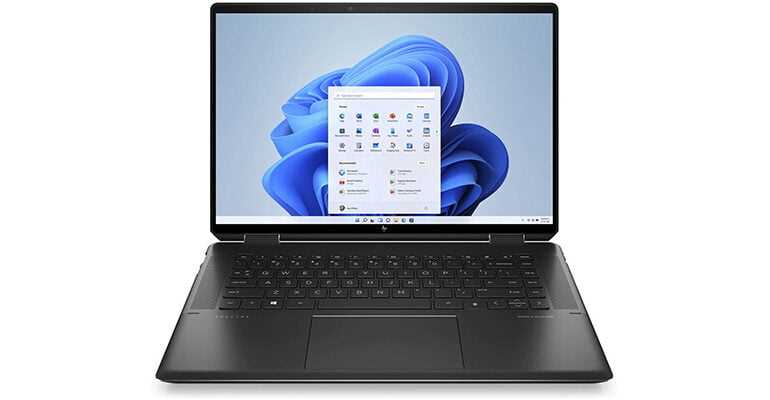HP’s 16-inch Convertible Specter x360 works with 11-inch Intel Core processorse generation, and an integrated Nvidia graphics card. Image: HP Inc.
HP’s Specter laptops have a distinctive design and come in four different sizes, with 13, 14, 15 and 16 inch screens. I was sent a 16-inch convertible Specter x360 to test, with a Core i7 processor, an integrated Nvidia GeForce RTX 3050 Laptop GPU and an OLED touchscreen. In France, the integrated graphics card offered is the Intel Iris Xe to date. The French price is 1,599 euros.
The HP Specter x360 16 on the HP site
HP gives the rear corners an angular design, using this feature to house a couple of ports – USB-C on the right, 3.5mm headphone jack on the left. The layout of the cables is not the neatest, but it is clearly distinctive.
Its construction is solid, with recycled CNC aluminum for a strong frame. HP provides a cover, which should protect the chassis from minor bumps and scratches.
Inevitably, given its 16-inch screen, this is a large and relatively heavy laptop. It is 9.5 ” wide, 14 ” deep and 1.99cm thick, and weighs 2.01kg. The power brick is also bulky.
The screen is more than good, it is superb
The name “x360” means that the laptop screen rotates on itself to face outward for use in tablet mode. However, working in tablet mode isn’t particularly comfortable on a 16-inch device. It is heavy, and it is impossible to hold it with one hand. And it’s a little difficult to put it on my lap or on the arm of a chair. However, sitting on a table in tent mode or with the screen facing a keyboard facing down, it works great for watching content. This is the usual compromise between screen size and usability.
The screen and speakers are both good, which will be just as useful for work as for entertainment. The Bang and Olufsen loudspeakers have a large sound volume without distortion, pushing the sound outwards through grilles located on the front base of the chassis, tilted upwards. This gives maximum access to audio, both in laptop and tablet mode. During video calls, an AI-enabled noise reduction system also comes into play.
The screen is more than good, it looks great. The device I tested had a UHD + OLED touchscreen (3840 x 2400, 283 ppi). With a maximum brightness of 400 nits, it was crisp and bright, even when running on battery power. Although I left the screen at the default settings for my battery wear test (see below), I might reduce them to conserve battery life in daily use.
The Shoulder Surfing function is too sensitive
The edges of the screen could be narrower, with the top and bottom edges a little deeper than those along the short edges, but the bottom edge is surprisingly small, resulting in a 16: aspect ratio: 10 which facilitates the display of documents. As a reminder, the screen / body ratio is 84.6%.
Above the screen is the webcam, which is an essential feature of this laptop. The 5MP camera shutter is activated by a hotkey rather than a physical slider. Seems a bit of a stretch – a less likely potential point of failure with a physical shutter. I wouldn’t want it to get stuck in the “covered device” position.
A series of camera functions are controlled by the HP Command Center app. One of them is auto framing, which helps make sure you stay in sight when moving around. Obviously, this cannot answer all eventualities, but it is a help for those who move around a bit during a video call, or who get up to access a document on a shelf, for example. I found that he followed me very well. Light correction helps reduce shadows on the face and darkens the background during calls. The HP command center also offers a beauty mode, the kind of feature most commonly seen on cell phones. It is basically about smoothing out wrinkles.
The camera can also be configured for other tasks in the HP Command Center, including locking and unlocking the laptop when you walk away and back, and to issue a warning if you get too close to the screen ( assuming that being too close is not good for the eyes). It can also be configured to have the screen automatically darken if you are not looking directly at it, a feature designed to save battery power. This function works well. However, the Shoulder Surfing feature, which is designed to alert you if someone is looking over your shoulder, was a bit too sensitive, alerting me to my own presence.
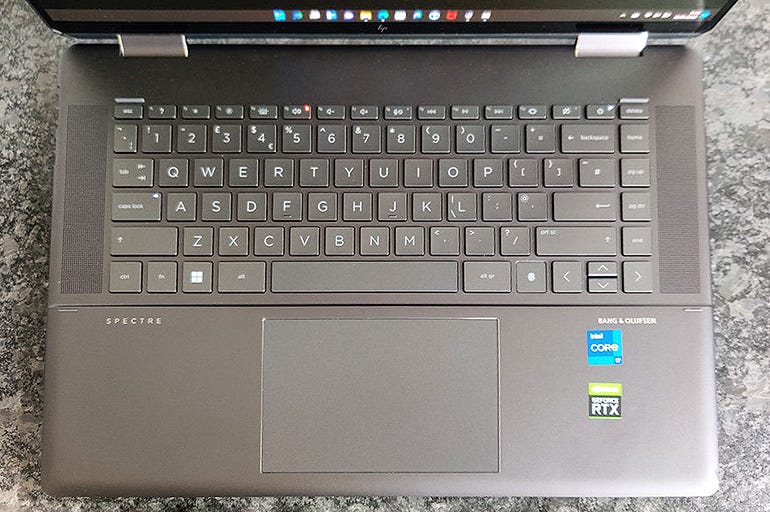
The keyboard has a responsive action, but there is no separate numeric keypad. Image: Sandra Vogel / ZDNet.
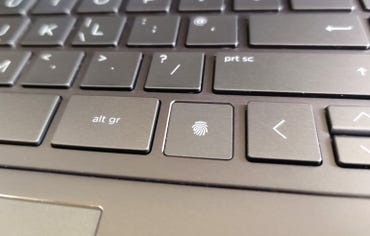
The fingerprint reader occupies a separate key space. Image: Sandra Vogel / ZDNet.
The 512 GB SSD is the weak link
The full keyboard is a comfortable typing platform, with springy and responsive action. The Enter key has only one height, but it is wide, and the arrow keys are tall. There’s a fingerprint sensor built into the lower row of keys, which is a bit of a waste of space, as it could easily have been built into the power key on the top row. Unlike some 16-inch laptops, there’s no separate number pad here. The touchpad is large and very responsive.
The hardware configuration holds the load. The 512GB SSD is the weak link, however: it seems too small given the high price tag of this laptop.
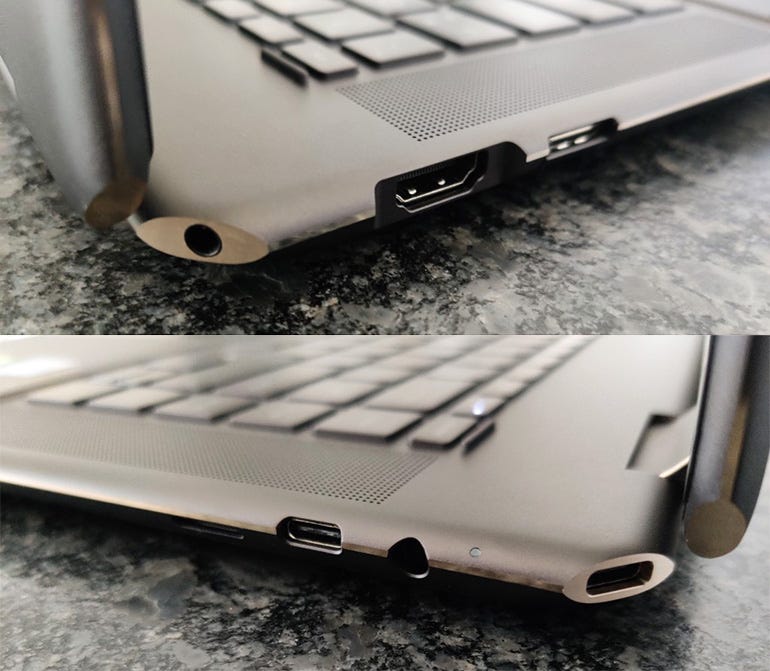
Left side (top): 3.5mm audio jack, HDMI, USB-A. Right side (top): microSD card reader, Thunderbolt 4 / USB-C, power, Thunderbolt 4 / USB-C. Images: Sandra Vogel / ZDNet.
A short day’s work without recharging the battery
It’s good to see a MicroSD card reader here on the right side. There are two Thunderbolt 4 USB-C ports, a single USB-A port, a full-size HDMI connector, and a 3.5mm headphone jack. The USB-A port is, unusually, partially hidden by a hinged cover. When the battery is charged via a round pin connector, the two USB-C ports are still available.
HP advertises up to 9 hours and 15 minutes of mixed use for the 83 Wh battery. To test this, I fully charged the battery, then worked for three hours using web apps, streaming video, and occasionally audio. During this time, the battery went from full to 52%, suggesting that a short working day (~ 6 hours) can be done on the battery, but a full 8 hour day would require access to the battery. mains power at a given time.
The charge has been a positive experience. Once, with a 30% battery, it dropped to 53% after 15 minutes, 65% after 30 minutes, and 77% after 45 minutes.
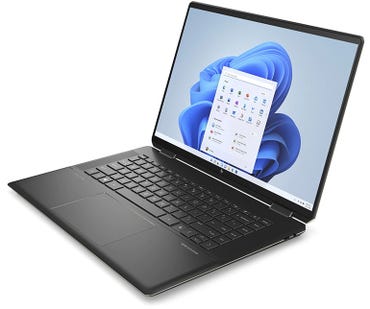
Image: HP Inc.
Conclusions on the Specter x360 16 inches
The 16-inch HP Specter x360 model reviewed here has a powerful processor, discrete graphics, and enough battery power to keep it running for most, if not all, of the day. The 16-inch OLED display is stunning, and the audio quality is good. However, considering the price, the SSD should be twice as big as its 512GB, and the size and weight of the laptop makes it unwieldy to use in portable tablet mode.
The HP Specter x360 16 on the HP site
Source: ZDNet.com
